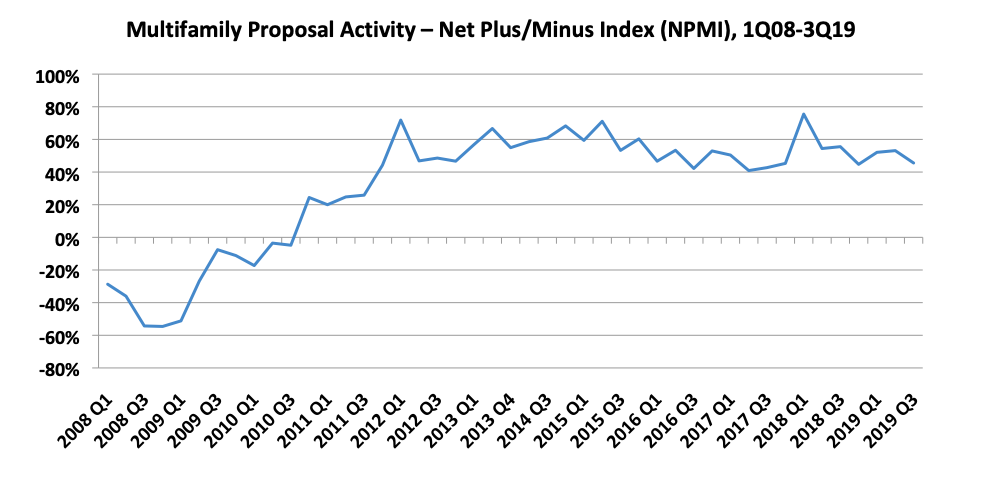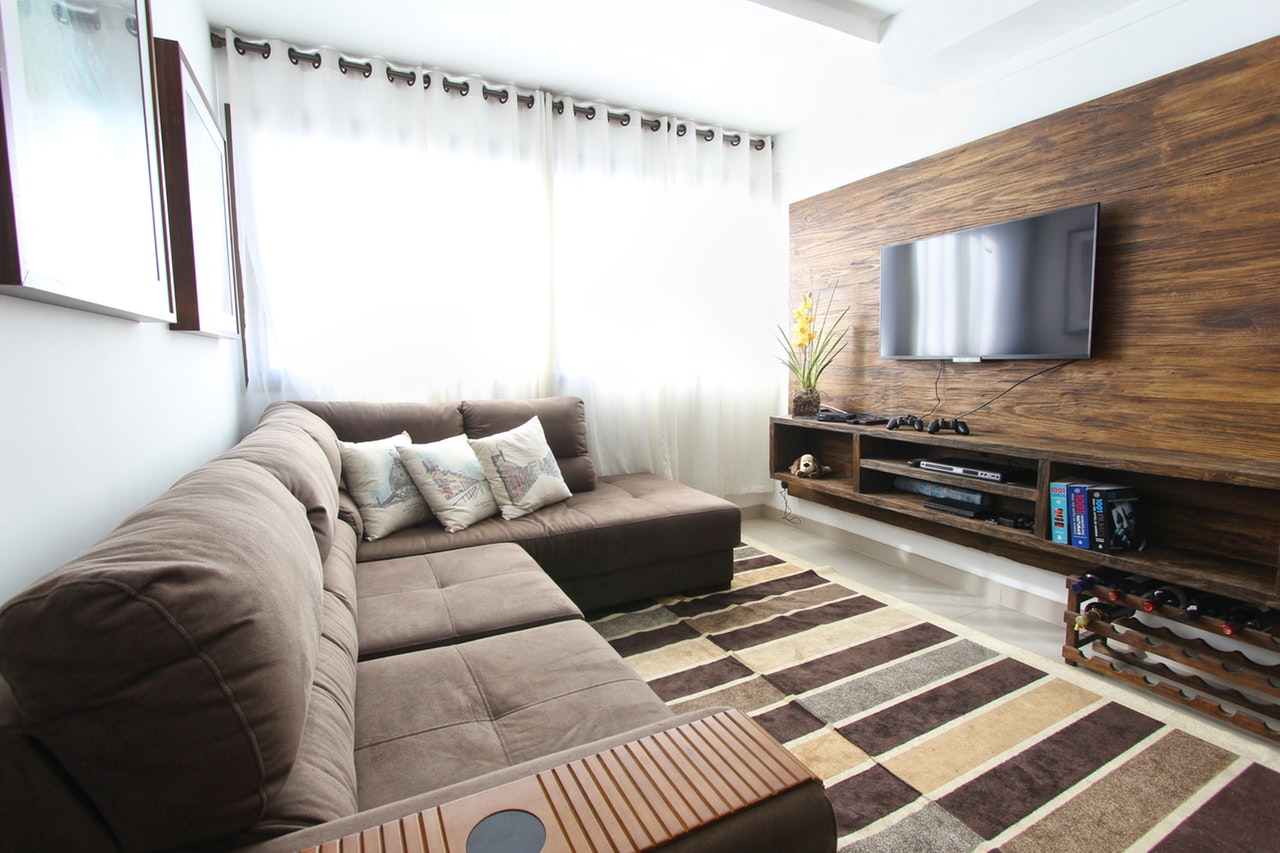Multifamily housing will remain a robust market for A/E/C companies heading into 2020, according to the most recent results of PSMJ’s Quarterly Market Forecast (QMF) survey. For the third quarter of 2019, the survey found that less than 9% of the nearly 100 respondents doing multifamily work reported a decrease in proposal activity compared with the prior quarter, while more than 54% saw an increase.
The Multifamily market’s third quarter Net Plus/Minus Index (NPMI) of 46% marked the 31st consecutive quarter that the submarket exceeded an NPMI of 40%. The last time it was below that level was the third quarter of 2011.
PSMJ’s NPMI measures the difference between the percentage of firms reporting an increase in proposal activity and those reporting a decrease, quarter over quarter. PSMJ has been using the QMF as a predictor of the A/E/C industry’s health since 2003, tracking 12 major markets and 58 submarkets every three months. The company chose proposal activity to gauge the industry’s long-term outlook because it is among the earliest stages of the project lifecycle. Approximately 200 firms participate in the survey each quarter.

The Senior and Assisted Living submarket also performed well with a third-quarter NPMI of 49%. Only 4 of the 86 responding firms working in the senior care submarket reported declining proposal activity. The Senior/Assisted Living market has also been a consistently stellar performer in the QMF. Its NPMI hasn’t dipped below 50% since the fourth quarter of 2012.
“Multifamily and Senior/Assisted Living have been two of the hottest markets for proposal activity for quite some time, not only among the Housing submarkets, but throughout all 58 submarkets,” says PSMJ’s Greg Hart, a consultant who also oversees the QMF. “It is remarkable that both have seen such steady proposal growth for so long. Very few submarkets have been this consistently strong throughout the 16-year history of our survey.”
Housing (all submarkets) recorded an NPMI of 40% in the third quarter, a potentially noteworthy drop from the 59% recorded in the second quarter. After ranking the second-highest of the 12 major markets measured in the second quarter, Housing fell completely out of the top five in the third quarter. Transportation (49%) and Healthcare (46%) were tops among major markets.
Among the other Housing submarkets, Condominiums recorded a respectable NPMI of 24%, its sixth consecutive quarter in the mid-20% range. Individual single-family homes (15%) and subdivisions (8%) trailed the Housing field in the third quarter, falling markedly from 25% and 23%, respectively, in the second quarter. PSMJ Director and Senior Consultant Dave Burstein, PE, notes that the results are still positive, if potentially troubling in the longer term. He adds that lower mortgage interest rates on the horizon are likely to spur a rebound in the single-family and subdivision subsectors.
PSMJ Resources, Inc., based in Newton, Massachusetts, is a publishing, executive education, and advisory company dedicated to serving architecture, engineering and construction (A/E/C) organizations worldwide.
Related Stories
MFPRO+ News | Nov 15, 2023
Average U.S multifamily rents drop $3 to $1,718 in October 2023: Yardi Matrix
Multifamily fundamentals continued to soften and impact rents last month, according to the latest Yardi Matrix National Multifamily Report. The average U.S. asking rent dropped $3 to $1,718 in October, with year-over-year growth moderating to 0.4%, down 40 basis points from September. Occupancy slid to 94.9%, marking the first decline in four months.
Industrial Facilities | Nov 14, 2023
Some AEC firms are plugging into EV charging market
Decentralized electrical distribution is broadening recharger installation to several building types.
MFPRO+ Special Reports | Nov 14, 2023
Register today! Key trends in the multifamily housing market for 2024 - BD+C Live Webinar
Join the BD+C and Multifamily Pro+ editorial team for this live webinar on key trends and innovations in the $110 billion U.S. multifamily housing market. A trio of multifamily design and construction experts will present their latest projects, trends, innovations, and data/research on the three primary multifamily sub-sectors: rental housing, senior living, and student housing.
Multifamily Housing | Nov 9, 2023
Multifamily project completions forecast to slow starting 2026
Yardi Matrix has released its Q4 2023 Multifamily Supply Forecast, emphasizing a short-term spike and plateau of new construction.
MFPRO+ News | Nov 1, 2023
Washington, D.C., Queens, N.Y., lead nation in number of new apartments by zip code
A study of new apartment construction by zip code showed Washington D.C., and the Queens borough of New York City are the hottest multifamily markets since 2018, according to RentCafe.
Adaptive Reuse | Nov 1, 2023
Biden Administration reveals plan to spur more office-to-residential conversions
The Biden Administration recently announced plans to encourage more office buildings to be converted to residential use. The plan includes using federal money to lend to developers for conversion projects and selling government property that is suitable for conversions.
Sponsored | MFPRO+ Course | Oct 30, 2023
For the Multifamily Sector, Product Innovations Boost Design and Construction Success
This course covers emerging trends in exterior design and products/systems selection in the low- and mid-rise market-rate and luxury multifamily rental market. Topics include facade design, cladding material trends, fenestration trends/innovations, indoor/outdoor connection, and rooftop spaces.
MFPRO+ Special Reports | Oct 27, 2023
Download the 2023 Multifamily Annual Report
Welcome to Building Design+Construction and Multifamily Pro+’s first Multifamily Annual Report. This 76-page special report is our first-ever “state of the state” update on the $110 billion multifamily housing construction sector.
Mass Timber | Oct 27, 2023
Five winners selected for $2 million Mass Timber Competition
Five winners were selected to share a $2 million prize in the 2023 Mass Timber Competition: Building to Net-Zero Carbon. The competition was co-sponsored by the Softwood Lumber Board and USDA Forest Service (USDA) with the intent “to demonstrate mass timber’s applications in architectural design and highlight its significant role in reducing the carbon footprint of the built environment.”

















